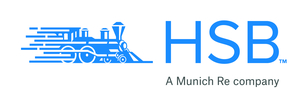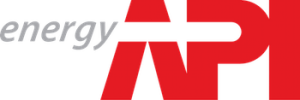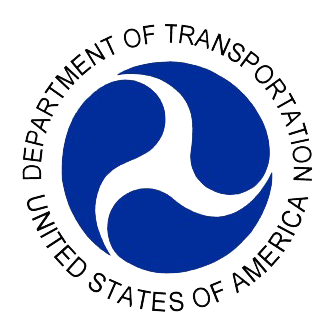What Are DOT 4B Cylinders?
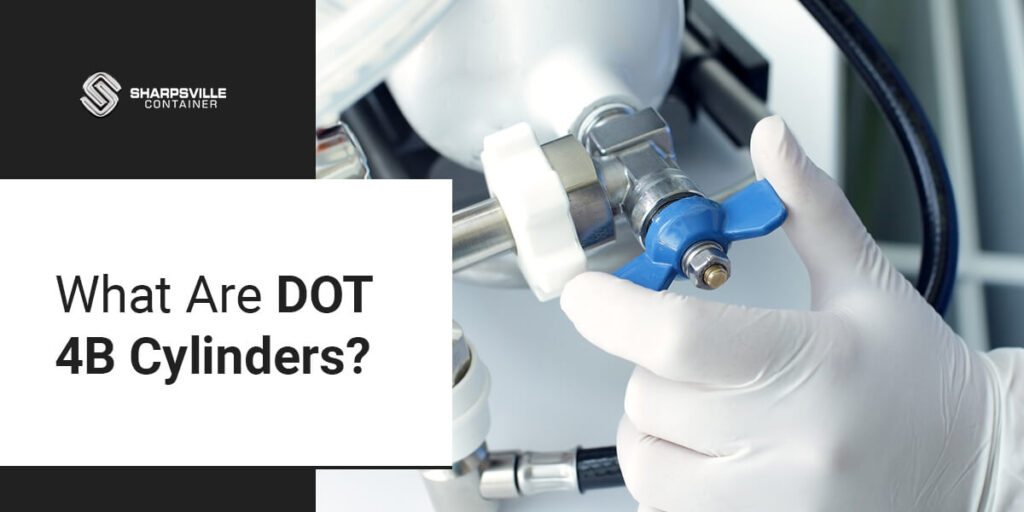
Shipping hazardous materials is a common practice in industries like industrial solvents, chemical manufacturing, pharmaceuticals and more. The companies that manufacture potentially dangerous or toxic gases, chemicals and other substances must adhere to stringent regulations developed by the United States Department of Transportation (DOT) to protect the public and anyone who handles the materials during transport.
The Code of Federal Regulations (CFR) codifies the rules published in the Federal Registrar by the various departments and agencies that comprise the federal government. The CFR — and the electronic e-CFR version that lists the frequent regulatory updates — consists of 50 titles representing the broad subject areas impacted by government regulations. Title 49, Part 48, Subsection C addresses the specifications for 4B cylinders.
DOT 4B Cylinder Specifications
The definition of a DOT 4B cylinder is a welded or brazed steel cylinder containing forged lap-welded or brazed longitudinal seams. It features a nominal water capacity of 1,000 pounds and a service pressure level ranging from 150-500 pounds per square in gauge (PSIG).
All 4B cylinders must meet the specifications in several critical areas. Examples include:
- Composition: The cylinder must consist of uniform-quality open-hearth process steel. The content percentages may not exceed 0.25% of carbon, 0.045% phosphorous and 0.05% sulfur.
- Material identification: All pressure-retaining materials require identification via a method that doesn’t compromise the cylinder’s integrity. Billets and plates for hot drawn cylinders need marking with the applicable heat number.
- Welding/brazing processes: Welding and brazing are the only acceptable practices for attaching pads, bosses, footrings, handles or neckrings to cylinder tops or bottoms. These attachments and the portions of the cylinder to which they’re affixed must consist of weldable steel with a carbon content of no more than 0.25%.
- Wall thickness: The thickness of the cylinder walls must meet several requirements based on the container’s outside diameter and other factors. It must also meet specific minimum test pressure guidelines.
- Heat treatment: The completed cylinder and the individual heads and bodies must receive heat treatment by approved methods.
- Cylinder openings: The placement of any opening must occur in locations other than a cylindrical surface. The opening in a spherical-type surface must include a weldable steel boss, fitting or pad attached via fusion welding. There are also guidelines for openings featuring straight or tapered threads.
- Mechanical tests: Testing must occur to determine the cylinder’s yield and tensile strength, elongation and reduction of material’s area.
- Flattening tests: Flattening testing must also take place on a randomly selected cylinder from each manufacturing lot consisting of 200 or fewer products. Cylinders constructed from lap-welded piping must undergo testing to detect cracking. If a cylinder fails the test, another test must occur with a second sample. A failure will result in the rejection of the entire lot.
- Markings: The DOT 4B cylinder specifications call for markings stamped plainly and permanently in one of several locations. These include the top head or shoulders, a sidewall adjacent to the top head, a cylindrical area of the shell extending beyond the cylinder’s recessed bottom, on a metal plate attached to the top of the cylinder, or on the neck, neckring or footing. Embossing the cylinder head or sidewall is not an acceptable practice.
How Are DOT 4B Cylinders Made?
DOT 4B cylinders must undergo a rigorous manufacturing process to ensure they meet the performance and quality requirements. Adhering to stringent production procedures increases the likelihood that the finished cylinder contains no defects that could jeopardize the product’s structural integrity. All welding procedures must comply with the CGA C-3 standards.
Companies must follow these steps when manufacturing a cylinder’s seams:
- Materials: The brazing materials should consist of copper or copper or silver alloys. If using a copper alloy, the composition must consist of copper content of at least 95% and include silicon (1.5%-3.85%) and manganese (0.25%-1.10%).
- Circumferential seams: Any heads attached via brazing must have a driving fit with the shell. The joint’s brazing depth should be at least four times the minimum thickness of the shell metal.
- Welding: It’s permissible to create circumferential seams via the welding process.
- Longitudinal seams: These seams must feature a forged lap joint design with a plate edge lapped at least eight times the plate’s thickness.
DOT 4B Cylinder Applications
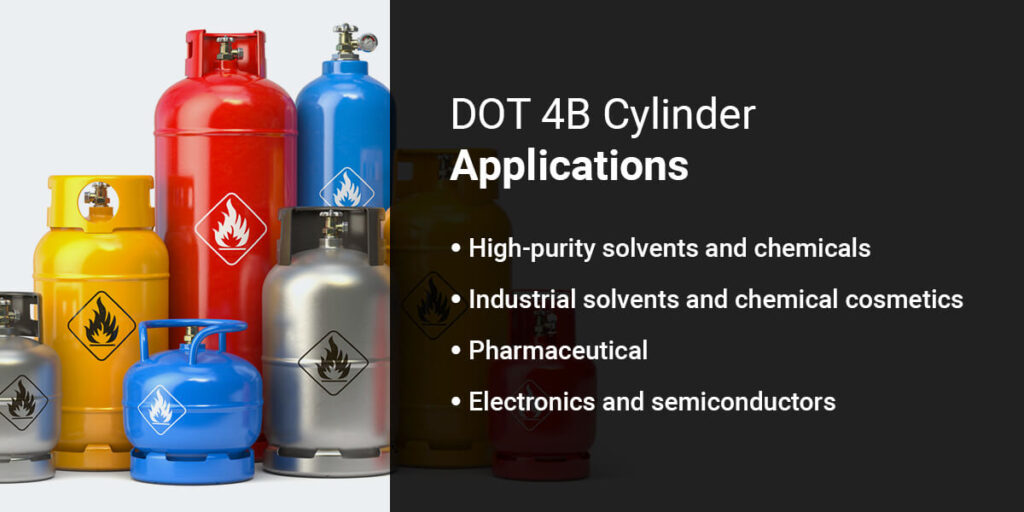
DOT 4B cylinders can serve the transportation needs of companies in a wide range of industries:
- High-purity solvents and chemicals: Includes corrosive materials like hydrochloric, acetic, sulfuric and nitric acid, and solvents like acetone, pyridine, toluene and methyl alcohol.
- Industrial solvents and chemical cosmetics: Encompasses materials such as hydrocarbon solvents, ethylene oxides and derivatives, oxygenated solvents and an assortment of specialty chemicals used in cosmetic manufacturing applications.
- Pharmaceutical: Consists of numerous chemicals and ingredients used to manufacture an assortment of medicinal drugs.
- Electronics and semiconductors: Covers the wide range of materials used to produce electronic products and components.
DOT 39 Cylinders vs. DOT 4B Cylinders
§ 178.65 Specification 39 under the CFR governs the use of DOT 39 cylinders. The most significant difference between DOT 4B and DOT 39 is that the latter refers to non-reusable, or non-refillable, containers.
A DOT 39 container is a seamless, brazed or welded cylinder consisting of a service pressure that doesn’t exceed 80% of the test pressure. Other specifications include:
- Size requirements: The maximum water capacity of DOT 39 cylinder may not exceed 55 pounds for a service pressure of 500 PSIG or less or 10 pounds for a service pressure greater than 500 PSIG.
- Test pressure: The minimum test pressure is either 180 PSIG or the maximum pressure contents at 130 degrees Fahrenheit, whichever is greater.
- Materials: The containers must consist of either steel or aluminum that meets specific requirements for material content and quality.
- Manufacturing: All cylinders must meet the CFR guidelines regarding the manufacturing process in areas such as seam design and strength, the application of cylinder attachments and welding procedures and practices.
Choose DOT 4B Cylinders From Sharpsville Container
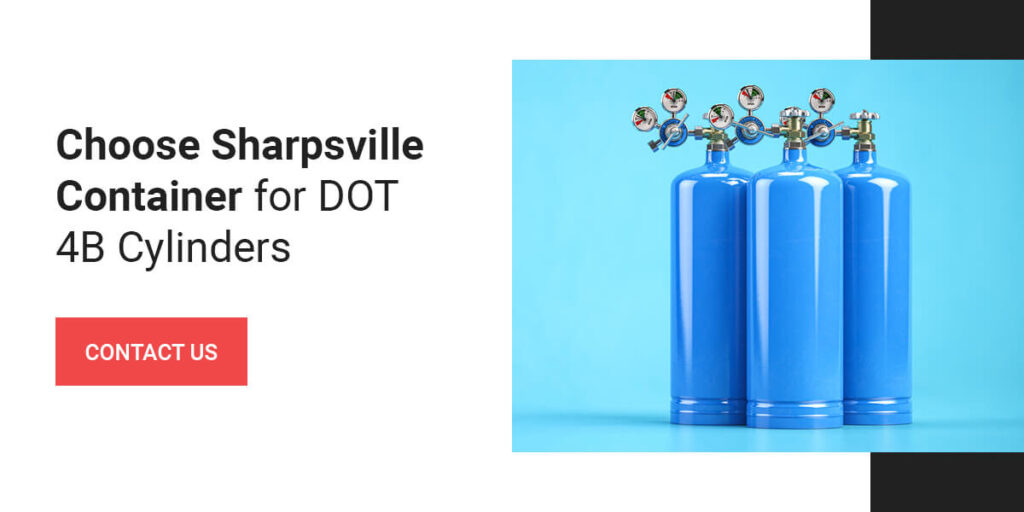
Sharpsville Container is a leading process equipment manufacturer that offers a full range of high-quality storage tanks and containers for sale, including UN/DOT transport vessels. We’re an ISO 9001-certified and code-approved company that manufactures our custom-engineered products in the U.S. Trust our more than 65 years of combined experience to find the best container solution for your business and transport applications.
We’ll be happy to meet face-to-face with you to discuss your company’s unique DOT 4B cylinder requirements. Call us at 800-645-1248 or contact us online for additional product and pricing information.
